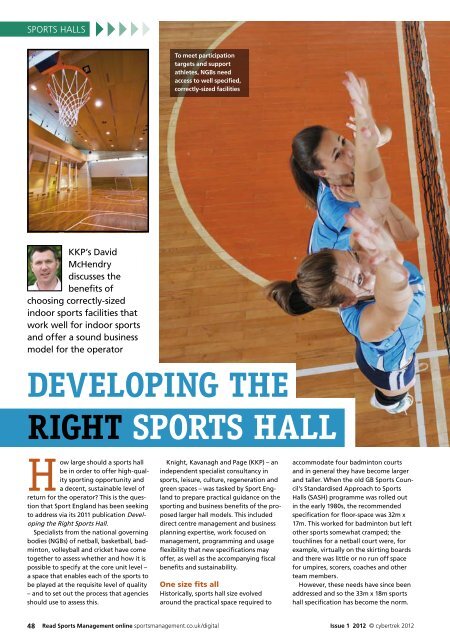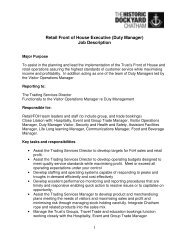Sports Management Issue 1 2012 - Leisure Opportunities
Sports Management Issue 1 2012 - Leisure Opportunities
Sports Management Issue 1 2012 - Leisure Opportunities
You also want an ePaper? Increase the reach of your titles
YUMPU automatically turns print PDFs into web optimized ePapers that Google loves.
SPORTS HALLS<br />
To meet participation<br />
targets and support<br />
athletes, NGBs need<br />
access to well specified,<br />
correctly-sized facilities<br />
KKP’s David<br />
McHendry<br />
discusses the<br />
benefits of<br />
choosing correctly-sized<br />
indoor sports facilities that<br />
work well for indoor sports<br />
and offer a sound business<br />
model for the operator<br />
DEVELOPING THE<br />
RIGHT SPORTS HALL<br />
H<br />
ow large should a sports hall<br />
be in order to offer high-quality<br />
sporting opportunity and<br />
a decent, sustainable level of<br />
return for the operator This is the question<br />
that Sport England has been seeking<br />
to address via its 2011 publication Developing<br />
the Right <strong>Sports</strong> Hall.<br />
Specialists from the national governing<br />
bodies (NGBs) of netball, basketball, badminton,<br />
volleyball and cricket have come<br />
together to assess whether and how it is<br />
possible to specify at the core unit level –<br />
a space that enables each of the sports to<br />
be played at the requisite level of quality<br />
– and to set out the process that agencies<br />
should use to assess this.<br />
Knight, Kavanagh and Page (KKP) – an<br />
independent specialist consultancy in<br />
sports, leisure, culture, regeneration and<br />
green spaces – was tasked by Sport England<br />
to prepare practical guidance on the<br />
sporting and business benefits of the proposed<br />
larger hall models. This included<br />
direct centre management and business<br />
planning expertise, work focused on<br />
management, programming and usage<br />
flexibility that new specifications may<br />
offer, as well as the accompanying fiscal<br />
benefits and sustainability.<br />
One size fits all<br />
Historically, sports hall size evolved<br />
around the practical space required to<br />
accommodate four badminton courts<br />
and in general they have become larger<br />
and taller. When the old GB <strong>Sports</strong> Council’s<br />
Standardised Approach to <strong>Sports</strong><br />
Halls (SASH) programme was rolled out<br />
in the early 1980s, the recommended<br />
specification for floor-space was 32m x<br />
17m. This worked for badminton but left<br />
other sports somewhat cramped; the<br />
touchlines for a netball court were, for<br />
example, virtually on the skirting boards<br />
and there was little or no run off space<br />
for umpires, scorers, coaches and other<br />
team members.<br />
However, these needs have since been<br />
addressed and so the 33m x 18m sports<br />
hall specification has become the norm.<br />
48 Read <strong>Sports</strong> <strong>Management</strong> online sportsmanagement.co.uk/digital<br />
<strong>Issue</strong> 1 <strong>2012</strong> © cybertrek <strong>2012</strong>
















